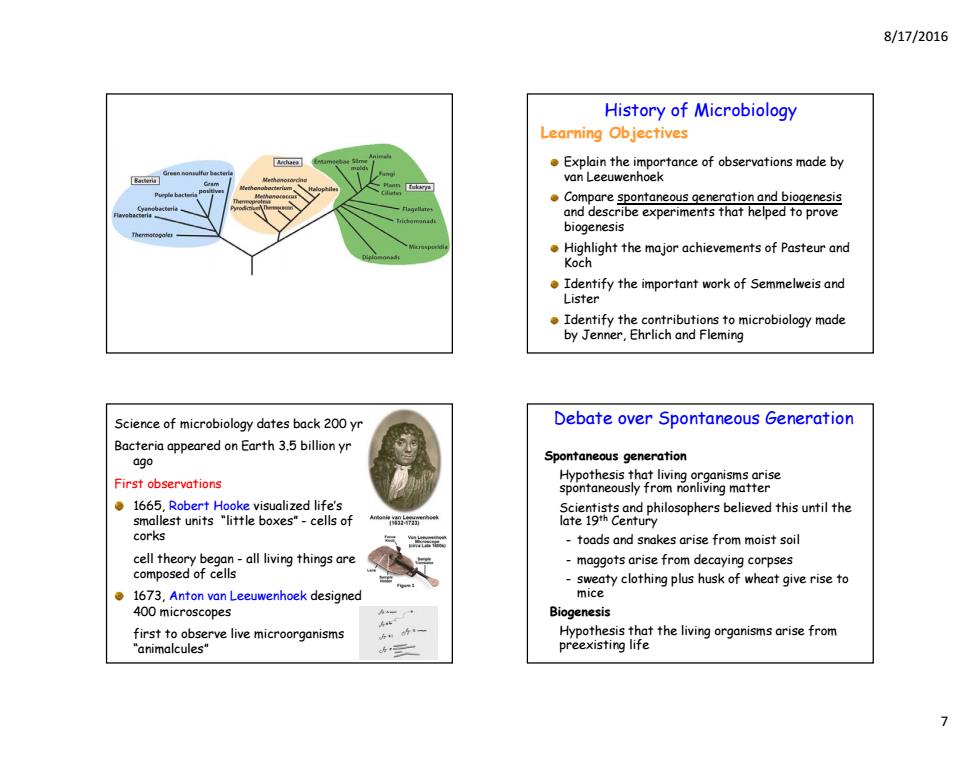
8/17/2016 Alga Algae Non-cellular,not strictly anogis/Viruses Photosynthetic eukaryotes Parasitic and only replicate within a living cell Cell walls of mary-cellulose Often cause damage to the host cell Found in fresh or salt water,soil,and in Hosts include microorganisms,plants,and animals association with plants HIV viru Only seen using an electron microscope Reproduce sexually or asexually ae enes and Virus particle-core made up of DNA or RNA(nucleic acid)surrounded by a protein coat that may be encased in a lipid membrane Virus particle Produce oxygen and carbohydrates used by other organisms Bacterial cell Important role in the balance of nature Genetic materia Helminths/Parasitic worms Classification of Microorganisms Not strictly a microorganism In 1978,Carl Woese devised a system of classification base ●Eukaryotic Tapesorms on the cellular organization of organisms Three-Domains of Life ●Multicellular Bacteria Parasitic and medically cell walls-peptidoglycan relevant Archaea Two major groups cell walls,if present,lack peptidoglycan flatworms and round worms Eukarya Protista (slime molds,protozoa,and algae) Microscopic stages of their life cycles Fungi (yeast,molds,mushrooms) Plants (mosses,ferns,conifers,and flowering plants) Animals (sponges,worms,insects and vertebrates) 6
8/17/2016 6 Photosynthetic eukaryotes Cell walls of many – cellulose Found in fresh or salt water, soil, and in association with plants Reproduce sexually or asexually Need light, water, and carbon dioxide for food production and growth Do not require organic compounds from the environment Produce oxygen and carbohydrates used by other organisms Important role in the balance of nature Alga / Algae Volvox aureus green alga found in lakes, ponds and ditches grass-green algae color due to two types chlorophylls Virus particle Bacterial cell Genetic material Virus / Viruses Non-cellular, not strictly an organism Parasitic and only replicate within a living cell Often cause damage to the host cell Hosts include microorganisms, plants, and animals Only seen using an electron microscope Virus particle – core made up of DNA or RNA (nucleic acid) surrounded by a protein coat that may be encased in a lipid membrane HIV virus Not strictly a microorganism Eukaryotic Multicellular Parasitic and medically relevant Two major groups flatworms and round worms Microscopic stages of their life cycles Helminths / Parasitic worms In 1978, Carl Woese devised a system of classification based on the cellular organization of organisms Three-Domains of Life Bacteria cell walls - peptidoglycan Archaea cell walls, if present, lack peptidoglycan Eukarya Protista (slime molds, protozoa, and algae) Fungi (yeast, molds, mushrooms) Plants (mosses, ferns, conifers, and flowering plants) Animals (sponges, worms, insects and vertebrates) Classification of Microorganisms

8/17/2016 History of Microbiology Learning Objectives Explain the importance of observations made by van Leeuwenhoek Compare spontaneous generation and biogenesis and descr be experiments that helped to prove biogenesis Highlight the major achievements of Pasteur and Koch Identify the important work of Semmelweis and Lister Identify the contributions to microbiology made by Jenner,Ehrlich and Fleming Science of microbiology dates back 200 yr Debate over Spontaneous Generation Bacteria appeared on Earth 3.5 billion yr ago Spontaneous generation First observations Hypothesis that living organisms arise spontaneously from nonliving matter 1665,Robert Hooke visualized life's Scientists and philosophers believed this until the smallest units "little boxes"-cells of late 19th Century corks toads and snakes arise from moist soil cell theory began-all living things are maggots arise from decaying corpses composed of cells sweaty clothing plus husk of wheat give rise to 1673,Anton van Leeuwenhoek designed mice 400 microscopes Biogenesis first to observe live microorganisms Hypothesis that the living organisms arise from animalcules" preexisting life
8/17/2016 7 Learning Objectives Explain the importance of observations made by van Leeuwenhoek Compare spontaneous generation and biogenesis and describe experiments that helped to prove biogenesis Highlight the major achievements of Pasteur and Koch Identify the important work of Semmelweis and Lister Identify the contributions to microbiology made by Jenner, Ehrlich and Fleming History of Microbiology Science of microbiology dates back 200 yr Bacteria appeared on Earth 3.5 billion yr ago First observations 1665, Robert Hooke visualized life’s smallest units “little boxes” - cells of corks cell theory began - all living things are composed of cells 1673, Anton van Leeuwenhoek designed 400 microscopes first to observe live microorganisms “animalcules” Spontaneous generation Hypothesis that living organisms arise spontaneously from nonliving matter Scientists and philosophers believed this until the late 19th Century - toads and snakes arise from moist soil - maggots arise from decaying corpses - sweaty clothing plus husk of wheat give rise to mice Biogenesis Hypothesis that the living organisms arise from preexisting life Debate over Spontaneous Generation